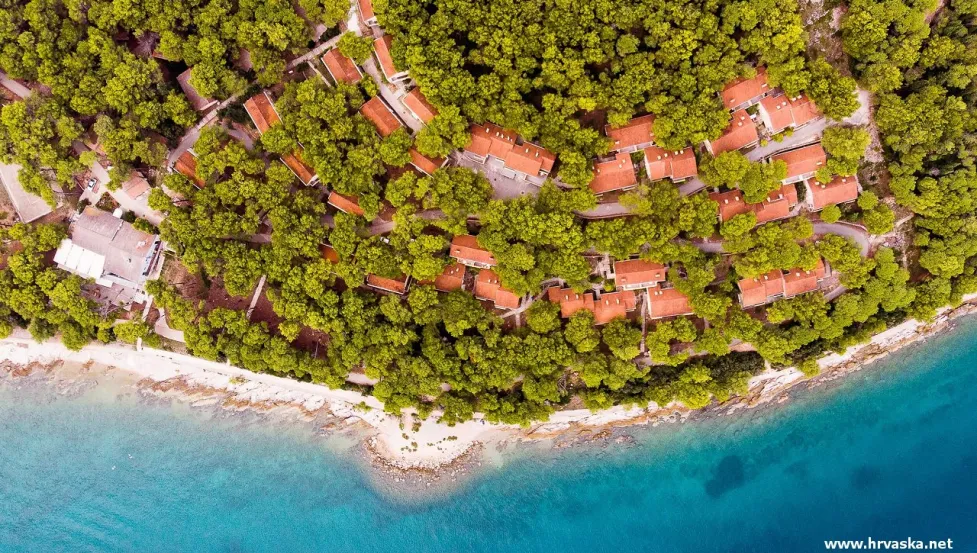Novigrad-Dalmacija
Novigrad is a small and picturesque historic town, situated in a long fjord on the southern coast of the Novigrad Sea. The old nucleus of the town, sheltered by an old fortress (Fortica) and surrounded by walls, is located on the slope of a hill on the northeast side of the bay. The architecture of Novigrad has, to a considerable extent, preserved its medieval appearance. Reports on the Novigrad population go back to the Bronze Age. At the site of the present fortress, there used to be the ruins of a settlement dating from the time of the Liburnians, the first settlers. The fortress and the urban area continued to exist during Roman times, as well as during the 7th century when the Croats settled on the territory of their present-day homeland; evidence of which is provided by numerous historic remains, particularly the churches and parts of the church furniture (plutei). Novigrad owes its name to a former fortress whose reconstruction was begun at the beginning of the 13th cent., and completed by the end of that century by the Kurjaković princes from Krbava, who, at the time, were the owners of Novigrad. The northeast part of the territory, today known as Ravni kotari, was under the jurisdiction of the same castrum (Castrum Novum) during the 14th century. An earlier name is not known. Queen Elisabeth, the wife of Louis I of Anjou, king of Croats and Hungarians, and their daughter Mary, who was engaged to Sigismund of Luxembourg, were imprisoned in the mentioned fortress from 1386 to 1387, following the death of king Louis I in a battle against rebellious nobility. According to tradition, Elisabeth had embroidered a golden clergyman’s dress (planita) for the Novigrad church during her imprisonment, and it is still kept to this day in the Novigrad parish church of St. Mary. Queen Elisabeth was killed in Novigrad, while her daughter Mary was freed. The Kurjaković family once again regained possession of Novigrad, and in 1392 Butko Kurjaković, the civil governor, renewed and enlarged St. Catherine church, at the time owned by the Franciscan monastery of the Bosnian vicarage. After being shamefully sold to the Venetian republic in 1409, Novigrad came under Venetian authority. It became the center of the district in the 15th century. The former Kurjaković fortress was reinforced at the end of the 15th and beginning of the 16th century, to protect the city from Ottoman attacks. Some parts of the old castrum were preserved. Although Novigrad lost its role as district center during the Ottoman presence in the region, it remained unconquered and along with Zadar continued its existence, the only towns in northern Dalmatia to do so. The old Croatian Common Law was written down in Novigrad in 1551. As stated in the introduction of the statute, this law applied “to the territory of Croatia extending from Knin to Nin.” After the liberation of Ravni kotari from the Ottomans, by the end of the 17th century, Novigrad became once again a distinguished administrative center of the region. Novigrad gained community status in 1811, following the presence of Austrian and Vatican consuls at the end of the 18th cent. Today, the Novigrad community consists of only three localities: Novigrad, Paljuv and Pridraga. It was also the center of the Nin diocese vicarage, and today it is the center of its diocese. Unlike the western walls, the eastern town walls of the Big Gate and a loophole are well preserved. The remains of St. Barbara chapel can be found inside the fortress. The chapel was later named the Assumption of St.Mary. At the entrance to Novigrad port there is the small church of St. Nicholas built in 1800. Outside the town walls there is the medieval church of St. Catherine with the remains of Benedictine and Franciscan monasteries. St. Mary’s church was built on old foundations within the town walls in 1500. The completion of a new parish church followed by the end of the 19th century, and it was built outside the town walls. St. Mary’s church was then converted into a school. It also accommodates a rich collection of cultural and historical documents (more than 2000 objects) for the home museum. The Pag bell, donated to Novigrad in 1587 by the inhabitants of Pag, is also kept there. The votive 16th century statue of Our Lady of the Seven Sorrows is kept in the parish church and specially honoured. The 5th century church of St. Martin, and the remains of the Early Croatian 9th century six-foiled church of St. Michael are found in the nearby village of Pridraga. Despite looting and the fact that both architectural and cultural inheritance were severely damaged during the 1991-1995 Croatian War for Independence, Novigrad has preserved the atmosphere of previous times. Part of its cultural heritage has been saved. Reconstruction is currently under way, to bring back to the city its original beauty. The Novigrad and Karin Seas are widely known for their rich fish and shells funds, in particular mussels. Oysters (and in earlier times even pearls) were found here until the beginning of the 20th century. Novigrad offers its tourists a pleasant stay in Mulić Camp, Aparthotel Agava, several full board rooms and apartments and numerous private houses to rent. Worth visiting are Zrmanja River Canyon, Obrovac town, the Karin Sea, the Franciscan monastery, the Velebit and National Parks Paklenica, Kornati islands, Krka and Plitvice, all easily accessible from Novigrad.





